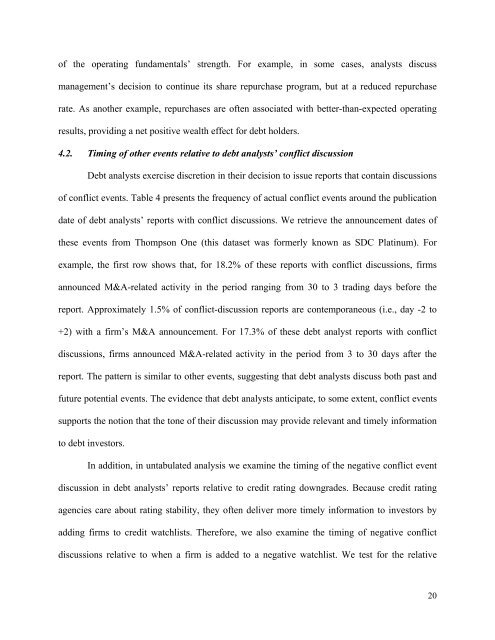Debt Analysts' Views of Debt-Equity Conflicts of Interest
Debt Analysts' Views of Debt-Equity Conflicts of Interest
Debt Analysts' Views of Debt-Equity Conflicts of Interest
Create successful ePaper yourself
Turn your PDF publications into a flip-book with our unique Google optimized e-Paper software.
<strong>of</strong> the operating fundamentals’ strength. For example, in some cases, analysts discuss<br />
management’s decision to continue its share repurchase program, but at a reduced repurchase<br />
rate. As another example, repurchases are <strong>of</strong>ten associated with better-than-expected operating<br />
results, providing a net positive wealth effect for debt holders.<br />
4.2. Timing <strong>of</strong> other events relative to debt analysts’ conflict discussion<br />
<strong>Debt</strong> analysts exercise discretion in their decision to issue reports that contain discussions<br />
<strong>of</strong> conflict events. Table 4 presents the frequency <strong>of</strong> actual conflict events around the publication<br />
date <strong>of</strong> debt analysts’ reports with conflict discussions. We retrieve the announcement dates <strong>of</strong><br />
these events from Thompson One (this dataset was formerly known as SDC Platinum). For<br />
example, the first row shows that, for 18.2% <strong>of</strong> these reports with conflict discussions, firms<br />
announced M&A-related activity in the period ranging from 30 to 3 trading days before the<br />
report. Approximately 1.5% <strong>of</strong> conflict-discussion reports are contemporaneous (i.e., day -2 to<br />
+2) with a firm’s M&A announcement. For 17.3% <strong>of</strong> these debt analyst reports with conflict<br />
discussions, firms announced M&A-related activity in the period from 3 to 30 days after the<br />
report. The pattern is similar to other events, suggesting that debt analysts discuss both past and<br />
future potential events. The evidence that debt analysts anticipate, to some extent, conflict events<br />
supports the notion that the tone <strong>of</strong> their discussion may provide relevant and timely information<br />
to debt investors.<br />
In addition, in untabulated analysis we examine the timing <strong>of</strong> the negative conflict event<br />
discussion in debt analysts’ reports relative to credit rating downgrades. Because credit rating<br />
agencies care about rating stability, they <strong>of</strong>ten deliver more timely information to investors by<br />
adding firms to credit watchlists. Therefore, we also examine the timing <strong>of</strong> negative conflict<br />
discussions relative to when a firm is added to a negative watchlist. We test for the relative<br />
20
















